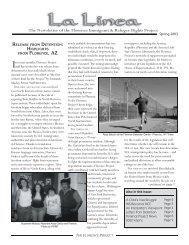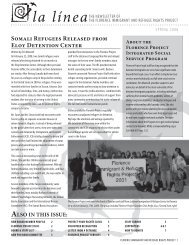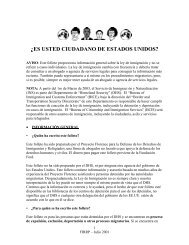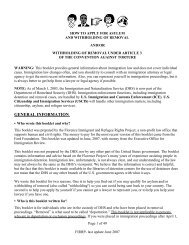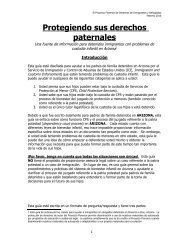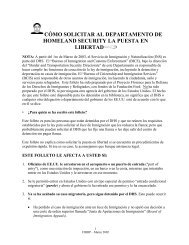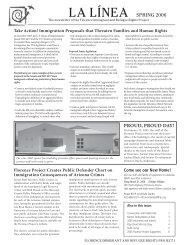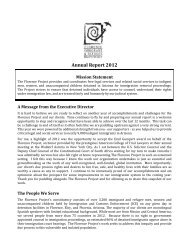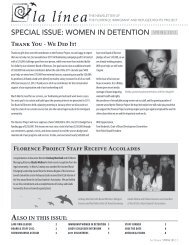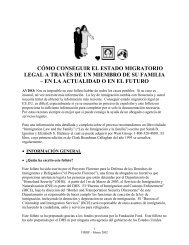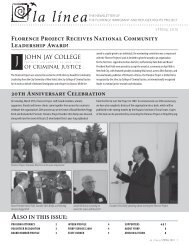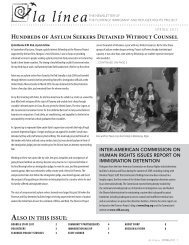quick reference chart and annotations for determining immigration ...
quick reference chart and annotations for determining immigration ...
quick reference chart and annotations for determining immigration ...
You also want an ePaper? Increase the reach of your titles
YUMPU automatically turns print PDFs into web optimized ePapers that Google loves.
Immigrant Legal Resource Center, Florence Immigrant <strong>and</strong> Refugee Rights Project,<br />
Maricopa County Public Defender August 2012<br />
3. If the person is one of two persons who have joint legal custody of a child takes, entices or withholds<br />
from physical custody the child from the other custodian.<br />
4. At the expiration of access rights outside this state, intentionally fails or refuses to return or impedes<br />
the return of a child to the lawful custodian.<br />
Crime Involving Moral Turpitude (CMT): Probably not, particularly <strong>for</strong> subsections A1, A2,<br />
<strong>and</strong> A3 since there is not necessarily an intentional or even reckless or negligent requirement. Even A4<br />
may not be a CMT since the statute does not require cruelty, depravity, or emotional harm. State v. Bean,<br />
174 Ariz. 544, 851 P.2d 843 (Ct. App. 1992).<br />
Aggravated Felony: It appears not to be, although as always counsel should try to avoid a<br />
sentence of a year or more <strong>for</strong> any single count.<br />
Other Grounds: Domestic Violence. Under 8 U.S.C. § 1227(a)(2)(E), a crime of child abuse,<br />
child neglect, or child ab<strong>and</strong>onment is a deportable offense. The Board of Immigration Appeals has<br />
broadly defined “child abuse” as an offense involving an “intentional, knowing, reckless, or criminally<br />
negligent act or omission that constitutes maltreatment of a person under 18 years old or that impairs such<br />
a person’s physical or mental well-being, including sexual abuse or exploitation.” Matter of Velasquez-<br />
Herrera, 24 I&N Dec. 503 (BIA 2008). The government may argue that a conviction <strong>for</strong> § 13-1302 will<br />
“impair the physical or mental well-being” of a child but <strong>immigration</strong> attorneys have arguments that it<br />
does not. A plea to unlawful imprisonment with no <strong>reference</strong> to § 13-3601 or the age of the victim may<br />
be safer.<br />
Other Grounds: Inadmissible <strong>for</strong> Taking a Child Outside the U.S. in violation of a custody<br />
Decree. Note that a noncitizen who removes a citizen child outside the U.S. in violation of a court<br />
decree, or assists in this, will be inadmissible until the child is returned to the rightful party.<br />
18. Unlawful Imprisonment, ARS § 13-1303<br />
A person commits unlawful imprisonment by knowingly restraining another person. “Restraint” is<br />
defined to mean restricting another person’s movements by “physical <strong>for</strong>ce, intimidation or deception” or<br />
“any means including acquiescence of the victim if the victim is a child less than eighteen years old or an<br />
incompetent person <strong>and</strong> the victim's lawful custodian has not acquiesced in the movement or<br />
confinement.” A.R.S. §13-1301. Unlawful imprisonment is a class 6 felony unless the victim is released<br />
voluntarily by the defendant without physical injury in a safe place prior to arrest in which case it is a<br />
class 1 misdemeanor.<br />
Summary: This is a divisible statute that may be a safer alternate plea, depending on sentence<br />
<strong>and</strong> record factors. To avoid an aggravated felony, counsel should obtain a sentence of less than 365 days<br />
<strong>for</strong> any single count, or at least keep the record clear of evidence that the restraint was effected by <strong>for</strong>ce.<br />
To avoid deportability under the domestic violence or child abuse ground, counsel should avoid evidence<br />
in the record that <strong>for</strong>ce was used or threatened against anyone with a domestic relationship, or abuse<br />
against a child was involved. In that case, while a §13-3601 notation will likely cause <strong>immigration</strong><br />
authorities to charge the offense under the domestic violence or child abuse ground, <strong>immigration</strong> counsel<br />
at least will have a strong argument against it being so held. Then it is crucial to try to bargain <strong>for</strong> a class<br />
1 misdemeanor, which will prevent the offense from being classed as a crime of violence. If the victim<br />
was a child <strong>and</strong> the record of conviction is silent as to the details, there are strong arguments that it is not<br />
a deportable child abuse offense.<br />
Arizona Criminal Chart with Explanatory Endnote – August 2012<br />
30



